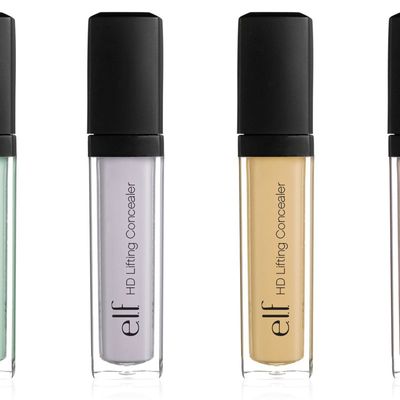
As someone who took her fair share of fine-art classes, I know that complementary colors — i.e., those opposite one another on the color wheel — neutralize each other. (If you want to get nerdy about it, it has to do with the different electromagnetic wavelengths of visible light.) Anyway! These days, my paintbrush usage is mostly limited to makeup, and not even that much of it. Aside from mascara, my daily routine involves covering up purple under-eye circles and red spots. Normally I just use plain cover-up that’s a tiny bit yellower than my skin tone. But when our beauty editor introduced me to E.l.f.’s four different tinted concealers, I was intrigued — doesn’t it make sense to use different tones for different skin problems? The dark areas under my eyes are a very different color from a blemish, after all.
E.l.f.’s kit includes the following pale tints: purplish-blue (“balancing”), light green (“adjusting”), faint yellow (“brightening”), and plain concealer for a light skin tone (“fair”). The liquid-y texture is easy to blend and layer; it doesn’t flake or ball up like some cover-ups do when you rub them in. And at $3 per wand, it gets the job done just as well as the much more expensive brands I’ve tried.
I started with the greenish “adjusting” concealer on the reddish areas of my face (around my nose, mostly). At first it looked … green. When I blended it with my fingers, it looked better, but still not entirely normal — I definitely looked like I had makeup on, which is never my goal, particularly when it comes to cover-up. I wound up washing it off, but it seemed like it could be useful for a situation in which evenness takes priority over looking natural — if you’re getting your picture taken, for example.
I then tried the faint yellow “brightening” color around my eyes. This was more successful. I looked awake and fresh-faced.
The lavender “balancing” color was a bit more perplexing. Purple’s complementary color is yellow, and I don’t have any yellowish areas on my face that need neutralizing. I dabbed tiny bits of it on my cheeks and forehead and rubbed it in, but it just gave me an unnatural pale tinge. I determined it was probably for a different skin tone than my pale, pinkish coloring — probably someone with more orange-y undertones.
But the most useful hue, in the end, was the plain old-fashioned “fair” wand, which looks just like the concealers I’ve been using all along. Too bad for color theory, but at least I haven’t been missing out.


